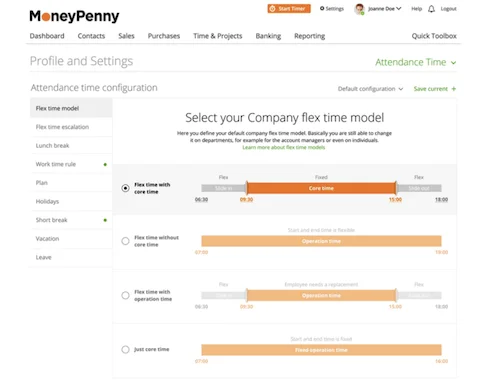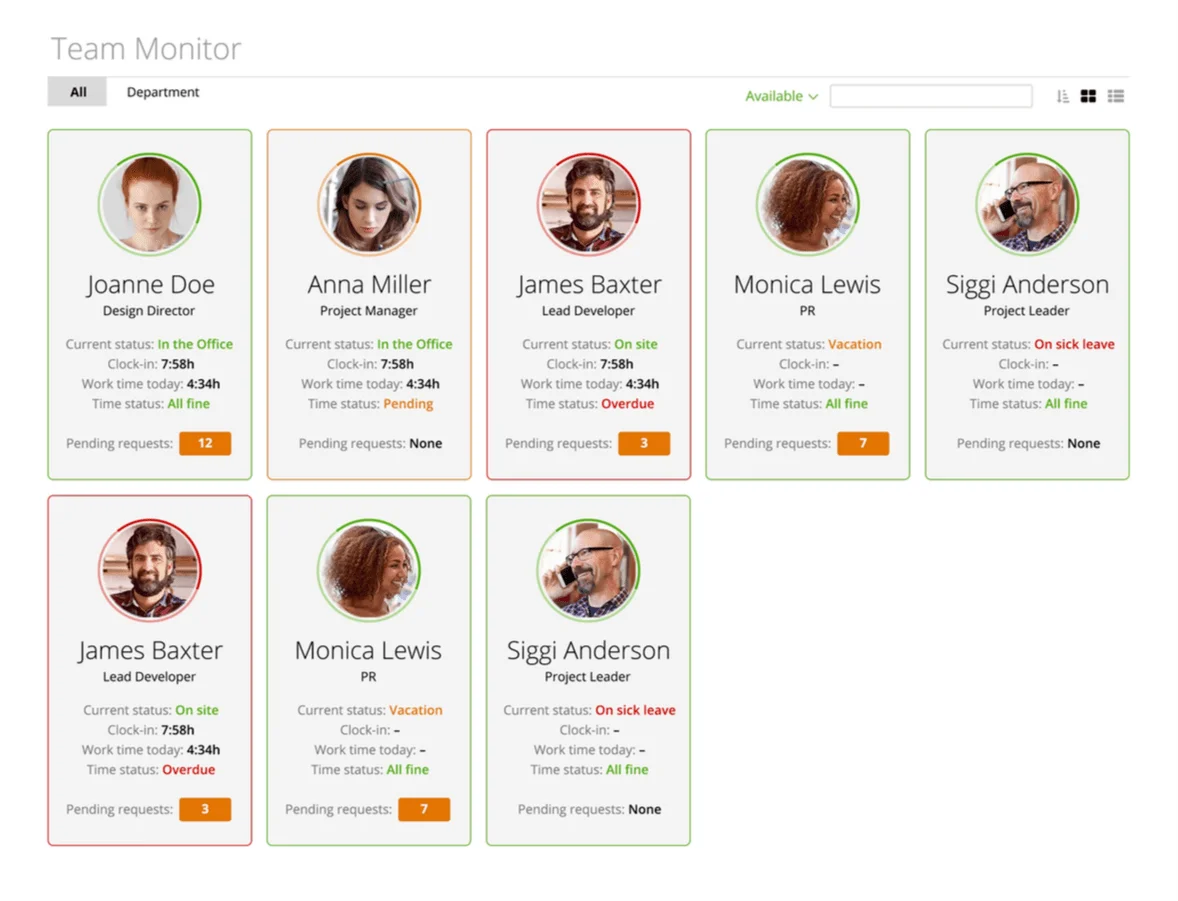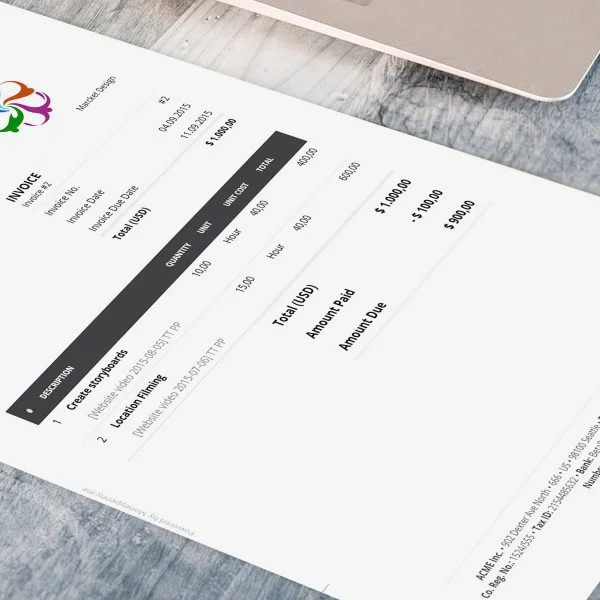Is your business up for the ultimate Time and attendance challenge? Make Flex Time work!
What is Flex Time?
A flex time policy is a flexible time scheme used by companies to organize working hours. It is allowing different starting and departure times. It usually includes a fixed “core time” interval – for instance from 11 am to 2 pm - when all employees must be in the office.
70% of employees felt that positions were more attractive if Flex Time was available
There’s no reason why in our modern world of digital technology and secure cloud computing that employees have to be at their desks from nine to five. When they can work at home for part of the time or choose their office hours, distractions like workplace politics and water-cooler chats disappear while staff morale is boosted. And, as an added bonus, take out the hour or more that many employees spend commuting to work during rush hour and a longer time can be devoted to productive employment.
Flex Time can work in different ways:
There are different ways in which Flex Time can work:
- setting up a core time when all employees must be in the office, and let them adjust the start and end work time due to personal needs
- employees can choose to work longer hours on some days to give them a three-day weekend or a mid-week day off
- they can split their time between working at home and their place of employment
‘Work’ becomes an activity rather than a ‘place’.
Setting Up Flex Time Rules in zistemo Time and Attendance Software
67% of employees wished that they were able to work flexible hours
Does Flex time work for all businesses?
In theory, any employee could work flexible hours. In practice, however, there are situations where it’s harder to manage such as when face-to-face customer interaction is required during specific hours.
Flex Time is easier to manage in employment situations that are less customer-focused such as distribution centers, production lines or the world of IT, many of which run 24-hours a day. In these situations, Flex Time can benefit both employers and employees. So, what are the pros and cons of Flex Time?
Benefits of Flex Time Model
Flex time model is beneficial for both employees and business owners.
58% of those surveyed believed that working away from the office would help their motivation
Good news for employees
An improvement in work-life balance. Without a rigid 9-to-5 working day, there is a positive gain for employees juggling the care of children or elderly relatives. With flexible hours, couples can often take on more of these roles themselves rather than paying for expensive childcare or care packages
Employees with ongoing health problems or treatment schedules can fit these into their lives without missing out on productive time while others who want to take professional courses can do so around their work life.
Employees on Flex Time can arrange their day to avoid peak rush-hour traffic or overcrowded trains. A valuable benefit that is much appreciated and may mean the difference between a highly qualified and experienced member of the team leaving and staying.
When employees aren’t worried about fitting in outside obligations, feeling guilty because they need time off for yet another appointment, or arriving hot and bothered after a nightmare commute, they’re freed up to focus on their job rather than personal issues. A win-win situation for them and their employers.
In-real Time Preview of Team Perfomrance with zistemo
Good news for business owners and managers
53% felt their productivity would increase if they could work outside the office
Having the ability to offer Flex Time means critical vacancies are more likely to attract the right staff to fill them. In fact, more and more qualified and experienced applicants expect it as a benefit of employment.
Flex Time allows businesses to make the most of its employees’ circadian rhythms. Night owls can work into the evening while those that rise with the lark can beat the traffic to make an early start on their daily tasks.
With flexible hours, employers can match staff presence to the times when demand for their service or business is at a peak. If the phone starts ringing at 6:00 am or techie support is needed late at night, then Flex Time means a ‘human’ voice is always available.
Flex Time can lead to lower overhead costs. When employees are working different hours, office equipment and space can be shared, having an impact on heavy overheads that might make all the difference when a small business is balancing its books.
Is it all good news?
How to overcome the cons of Flex Time?
Many businesses have been using flexible scheduling for some years now, meaning the downside of Flex Timehas become more apparent. What works beautifully in one situation, can be a massive headache in another.
If your business employs just a handful of people, scheduling in those flexible hours is straightforward. When a company has hundreds, if not thousands, of employees, trying to meet their needs and keep daily operations running smoothly can become a Human Resources nightmare. To keep things running smoothly and bring teams together, some employees may have to come into work during their own hours - not good for either morale or motivation.
When people are sharing roles and responsibilities their working methods and styles need to gel and communication between them needs to be ultra-effective. If not, projects will suffer from delays and inconsistencies.
Businesses often run on teamwork and for employees working in a team and building a relationship with co-workers is an enjoyable and motivating part of their work life. Friendships and even romantic relationships are made at work but when everyone is starting and finishing at different times or spending hours working at home, the chance to come together over a morning cup of coffee or an after-work drink can be lost.
3 Tips to Make Flex Time work for your business!
There is no legal requirement to offer Flex Time to employees. Although business owners can limit Flex Time to specific situations, if it is offered it cannot be discriminatory and should be available to all workers. To ensure it works for your business:
- write clear policies for staff and managers to follow then embed these in your employee handbook and make them part of your initial staff training procedures.
- Simplify personnel scheduling by making use of our Automated Time Attendance Software. Employers and employees can easily keep track of working hours with this cloud-based software package. When data is collated and clearly displayed on time sheets, managing Flex Time immediately becomes quicker and easier.
- Use live time tracker and know in real time who is working on which project, who is on holiday or even who is taking a lunch break. It shows which employee is in the office and who is working from home or elsewhere, allowing for close monitoring of both teamwork and productivity.
30% if given the choice, would prefer the opportunity to work flexible hours rather than have a pay rise
Set up and mange Working Hours with zistemo
Our Automated Time Attendance software also feeds data seamlessly into payroll preparation while keeping a track of tax, social security, pension and holiday pay obligations.
A reliable automated tracking system that employees trust does away with workplace resentment. When everyone’s hours are monitored, workers that used to add a few minutes to their lunch breaks or habitually arrived late and left early can no longer do so without being caught out.
With the right policies in place and the right software, your business is ready for the ultimate time and attendance challenge - Flex Time.
Find out some more interesting stats about flex time from a 2017 survey by powwownow.co.uk








